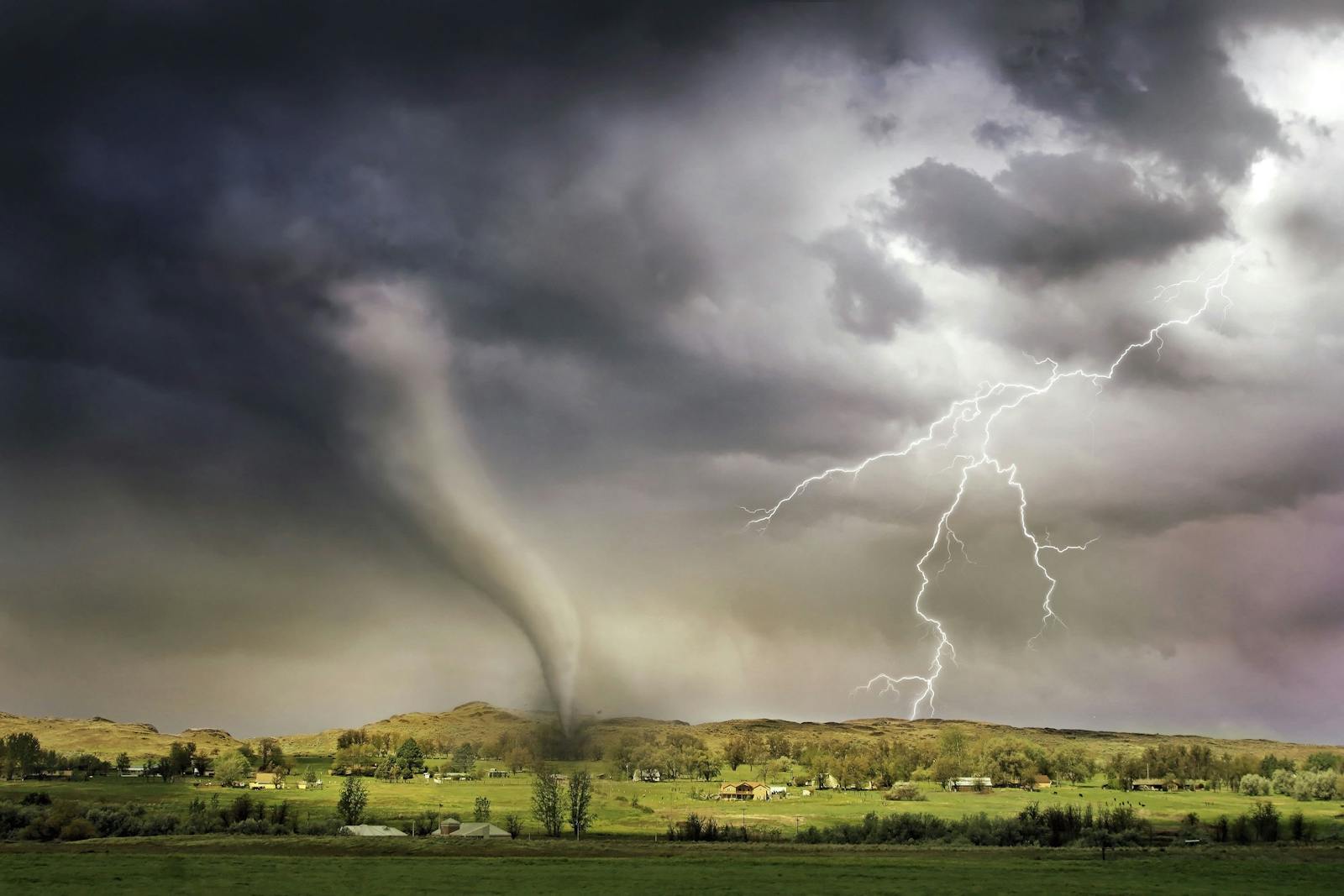Tornadoes are one of nature’s most powerful and destructive forces, capable of producing winds over 300 miles per hour and causing widespread damage within minutes. These violently rotating columns of air extend from thunderstorms to the ground and can wreak havoc on anything in their path. Despite their often-brief lifespan, tornadoes can have a lasting impact on communities, and understanding how they form is essential for improving early warning systems and minimizing loss of life.
The formation of tornadoes involves a combination of atmospheric conditions, including warm and cold air interaction, wind shear, and instability within the atmosphere. In this guide, we’ll explore the science behind tornadoes, focusing on the meteorological processes that lead to their formation, the stages of development, the types of tornadoes, and the environmental factors that influence their intensity. By understanding the complex processes that contribute to tornado formation, we gain insight into the conditions that trigger these deadly storms and the methods meteorologists use to predict them.
The Basics of Tornado Formation: Key Atmospheric Ingredients
Several key atmospheric ingredients must come together for a tornado to form. These include warm, moist air near the surface, cold, dry air above it, wind shear, and instability in the atmosphere. Each of these factors plays a unique role in creating the conditions necessary for tornado formation.
1. Warm, Moist Air and Cold, Dry Air
Tornadoes typically form when a layer of warm, moist air near the ground interacts with a layer of cool, dry air above it. This contrast in temperature and moisture levels creates atmospheric instability, which is essential for thunderstorm development. When the warm air rises and collides with the cooler air, it begins to cool and condense, forming large clouds and eventually thunderstorms. In the United States, tornadoes often form in the spring and summer months when warm, humid air from the Gulf of Mexico meets cool, dry air from the Rocky Mountains or Canada, particularly in the region known as Tornado Alley.
2. Wind Shear
Wind shear refers to changes in wind speed and direction with altitude. In tornado formation, wind shear causes the air to rotate horizontally within a storm system. For instance, if the wind at the surface is blowing from the south, while higher-altitude winds are blowing from the west, this creates a rotational effect. Wind shear is critical in tornado formation because it provides the rotation that, under the right conditions, can be tilted from a horizontal to a vertical position, creating the beginnings of a tornado.
3. Atmospheric Instability
Instability in the atmosphere occurs when warm air near the surface rises rapidly and begins to cool as it encounters colder, denser air above. This rising warm air can cause updrafts, which help lift and rotate the horizontally spinning air caused by wind shear. If instability is strong enough, the updrafts within a thunderstorm can become more intense, creating a powerful supercell storm—a type of storm capable of producing tornadoes.
4. Supercell Thunderstorms
Most tornadoes form from supercell thunderstorms, which are large, rotating thunderstorms characterized by a deep, rotating updraft known as a mesocyclone. Supercells develop when there is a combination of strong wind shear and atmospheric instability. As the mesocyclone intensifies, it can lower toward the ground, creating the conditions necessary for tornado formation. Supercells are particularly dangerous because they can produce large hail, strong winds, and multiple tornadoes within a single storm system.
The Stages of Tornado Formation
The process of tornado formation can be broken down into several stages, each representing a step in the development of a full-fledged tornado. These stages begin with the development of a rotating storm and culminate in the formation of a visible funnel that touches the ground.
1. The Development of a Mesocyclone
The first stage in tornado formation is the development of a mesocyclone within a supercell thunderstorm. A mesocyclone is a rotating column of air, typically about 2 to 6 miles in diameter, that forms due to wind shear. As wind speeds and directions vary with altitude, they create rotation within the storm. When updrafts lift this rotating air from horizontal to vertical, a mesocyclone begins to form. At this point, the storm becomes organized and exhibits the rotating structure necessary for potential tornado development.
2. The Formation of a Funnel Cloud
As the mesocyclone intensifies, it may begin to stretch vertically and narrow, increasing its rotational speed due to the conservation of angular momentum (similar to how an ice skater spins faster when they pull in their arms). Eventually, a funnel cloud—a visible, rotating extension of the storm cloud—forms. This funnel cloud is not yet a tornado, as it has not touched the ground. However, the presence of a funnel cloud indicates that conditions within the storm are favorable for tornado formation, and meteorologists may issue a tornado warning at this stage.
3. Tornado Touchdown
When the funnel cloud extends from the mesocyclone to the ground, it officially becomes a tornado. Upon touchdown, the tornado begins to draw in debris, dust, and moisture, making the rotating column visible to observers. The tornado’s intensity depends on several factors, including the strength of the mesocyclone, the level of instability in the atmosphere, and the degree of wind shear present. Once a tornado touches the ground, it can cause significant damage, with wind speeds reaching up to 300 miles per hour in the most extreme cases.
4. Tornado Dissipation
Eventually, the tornado weakens and dissipates. This often occurs when the updraft within the storm loses strength or when cooler air from the surrounding environment begins to disrupt the tornado’s structure. As the updraft weakens, the tornado may narrow and lose its strength until it dissipates entirely. This stage is known as tornado decay or the rope stage, during which the tornado appears as a narrow, twisted rope extending from the cloud base. Even during this final stage, tornadoes can still cause damage, though they are typically less intense than at their peak.
Types of Tornadoes
Not all tornadoes are the same; they vary in structure, intensity, and formation process. Meteorologists classify tornadoes into different types based on their characteristics, including size, duration, and wind speed.
1. Supercell Tornadoes
Supercell tornadoes are the most common and often the most intense type of tornado. They form from supercell thunderstorms and are associated with strong mesocyclones. These tornadoes can reach extreme wind speeds and cause widespread destruction, particularly when they persist for long durations. Supercell tornadoes are typically large and have well-defined funnels, making them highly visible and easier to track.
2. Non-Supercell Tornadoes
Non-supercell tornadoes form from thunderstorms that do not exhibit the classic rotating structure of a supercell. These include landspouts and waterspouts:
- Landspouts are small, relatively weak tornadoes that form from rapidly rising air and usually lack a mesocyclone. While less destructive than supercell tornadoes, landspouts can still cause localized damage.
- Waterspouts are similar to landspouts but occur over bodies of water. They typically form in tropical or subtropical regions and are often less intense than their land-based counterparts, though they can pose risks to boats and coastal areas.
3. Gustnadoes
Gustnadoes are short-lived, small tornadoes that form along gust fronts or outflow boundaries, often during a thunderstorm. They are typically weaker than supercell tornadoes and do not stem from a mesocyclone, which limits their intensity and lifespan. While gustnadoes can cause minor damage, they are generally less dangerous than larger tornadoes.
Factors Affecting Tornado Intensity
The intensity of a tornado is influenced by multiple factors, including wind shear, atmospheric instability, and the strength of the mesocyclone. Tornadoes are rated on the Enhanced Fujita (EF) Scale, which measures their strength based on estimated wind speeds and the damage they cause:
- EF0 (65–85 mph): Minor damage, such as broken tree branches and damaged signs.
- EF1 (86–110 mph): Moderate damage, including uprooted trees and damaged roofs.
- EF2 (111–135 mph): Considerable damage, such as torn-off roofs and overturned vehicles.
- EF3 (136–165 mph): Severe damage, including destroyed walls and heavy structural damage.
- EF4 (166–200 mph): Devastating damage, with houses leveled and large debris airborne.
- EF5 (over 200 mph): Incredible damage, with reinforced structures destroyed and large objects displaced.
The EF scale is essential for assessing tornado impact and helps emergency responders gauge the level of destruction in affected areas.
Tornado Alley: The Perfect Storm Conditions
In the United States, Tornado Alley—a region spanning Texas, Oklahoma, Kansas, Nebraska, and parts of other nearby states—is known for its frequent and intense tornadoes. Tornado Alley experiences unique atmospheric conditions where warm, moist air from the Gulf of Mexico meets cold, dry air from Canada and the Rocky Mountains. This combination, along with strong wind shear, creates the perfect conditions for supercell thunderstorms and tornado formation. The flat terrain in this region also contributes to tornado development by allowing storms to form and move without interference from mountains or other large geographical features.
Forecasting and Predicting Tornadoes
Advancements in technology have greatly improved tornado forecasting, but predicting the exact timing and location of tornadoes remains challenging due to their rapid and unpredictable nature.
Doppler radar is one of the most effective tools in tornado prediction, as it can detect rotation within thunderstorms and identify potential mesocyclones. Meteorologists use radar to track supercell storms and issue tornado watches and warnings when conditions indicate a high probability of tornado formation.
Tornado watches are issued when atmospheric conditions are favorable for tornado development, while tornado warnings are issued when a tornado has been spotted or indicated by radar. In addition to Doppler radar, storm spotters and weather satellites provide valuable information, allowing meteorologists to monitor severe weather events in real time and warn communities at risk.
Safety Precautions During a Tornado
Tornadoes are highly destructive, but taking appropriate safety precautions can help protect lives. If a tornado warning is issued, seeking shelter in a basement or an interior room on the lowest floor of a sturdy building is the safest option. Avoid windows and cover yourself with a mattress or sturdy object to protect against flying debris. Those in mobile homes or vehicles should find a nearby storm shelter or a well-constructed building if possible, as these structures provide little protection against tornadoes.
Conclusion
The formation of tornadoes is a complex interplay of atmospheric conditions, including warm and cold air interaction, wind shear, and atmospheric instability, often leading to the development of supercell thunderstorms. Tornadoes can form in various ways, but most occur when a rotating mesocyclone within a supercell stretches toward the ground, forming a visible funnel that can reach wind speeds of over 300 miles per hour. Although predicting tornadoes is challenging, advancements in meteorology, such as Doppler radar and storm-spotting programs, have improved our ability to forecast and respond to these dangerous events.
Tornadoes are awe-inspiring yet devastating natural phenomena, underscoring the need for ongoing research and safety awareness. By understanding how tornadoes form and the conditions that lead to their development, we are better equipped to prepare for and respond to these powerful storms, minimizing their impact on lives and property.




